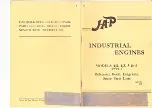
Commissioning and operation
25
If an alarm is activated, the device switches automatically to the alarm screen. Each new
entry is made in the top line. Any messages that might already be present shift one line
downwards. In a column to the right of this, the code and current time are added. Al-
though a warning (message without alarm) is entered in the alarm screen, there is no au-
tomatic switch to that screen, e.g. in the case of a programmed ship alarm or ship-spe-
cific warning, see page 31.
The following codes are distinguished:
Warnings:
without code
Warnings (preliminary alarms):
WA
Main alarms:
AL
Sensor error alarms:
SE
Example:
Message text
Code
Time
A1
Coolant temperature
WA
14:14
Charge-air temperature
SE
13:57
Coolant level
11:00
Oil pressure, engine
AL
08:37
Bilge pump ON
Programmed ship-specific warning
If there are more than 5 alarms (e.g. during commissioning in the shipyard), the alarms
can be displayed in groups of five (A2 to An) by pressing the “
ALARMS
” key again.
All alarms are always displayed in reverse order of their occurrence. The alarm gener-
ated last is therefore located in the first line of the alarm screen. As long as at least one
alarm is active, the red LED “
Alarm
” to the right of the display lights up.
Alarms
If an engine alarm from the central unit MMDS or an alarm configured by the user is is-
sued, the built-in buzzer is activated and the LED “Alarm” flashes. At the same time, the
monitor switches automatically to the alarm screen. The new alarm is entered in the first
line as a flashing message.
The alarms that would be issued if the engine is stopped but the engine ignition is on
(e.g. lack of oil pressure) are suppressed (disabled) until the green LED “Engine run”
lights up. This occurs approx. 8 seconds after ignition engine speed has been reached.
















































